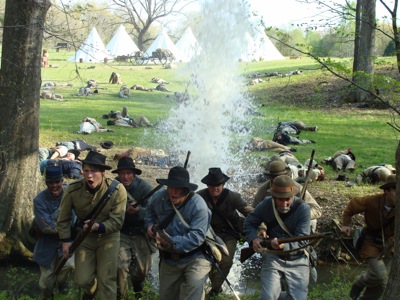
Courtesy Shiloh National Military Park
From soldiers to singers, the figures of western Tennessee legend make a tour through this part of the state an entertaining and enlightening experience.
Everyone knows about Elvis Presley and his Graceland mansion in Memphis. Although Graceland is a perennial favorite, groups willing to travel outside of the city will find a rich heritage in history and culture. The West Tennessee Delta Heritage Center introduces visitors to Tina Turner, Carl Perkins and some of the other famous musicians from the area.
Near the Mississippi border, Shiloh National Military Park honors the site of one of the most significant battles of the Civil War, giving visitors insight into the events that took place there and how they helped shape American history.
These sites are part of two new driving trails in western Tennessee. Starting in Memphis, groups can visit Graceland and Shiloh on the Walking Tall Trail or swing by the West Tennessee Delta Heritage Center as part of their trip along the Cotton Junction Trail.
Graceland
Memphis
For decades, Graceland has been one of the leading tourist attractions in Tennessee, drawing throngs of visitors who come to see Presley’s famous home and accompanying museum. This year, three new exhibits at Graceland give guests a look into aspects of Elvis’ life and legacy.
The largest new exhibition is “Elvis: His Hip-Shaking, Groundbreaking, News-Making Story,” which chronicles how the media covered Elvis during his lifetime and beyond. Much of the exhibit focuses on initial public outcry against rock ’n’ roll in the 1950s; other parts go on to include items that Elvis wore during news-making events.
“You’re going to find the belt that Elvis was wearing when he met Richard Nixon, and the badge that Nixon gave Elvis when they met at the White House,” said Kevin Kern, director of public relations at Graceland. “You’ll also find a jumpsuit from Elvis’ ‘Aloha From Hawaii’ concert. More people saw Elvis in this concert on television than saw the landing on the moon.”
Another exhibit, “The Roots of Elvis,” is part of a VIP admission to Graceland and focuses on the influence that sacred music had on Elvis’ career. The exhibit includes the Grammy award that he won for his gospel album.
The third new exhibit, “1956: The Rise of Rock ’n’ Roll,” highlights the pivotal year when Elvis went from being a regional Southern performer to an international superstar.
West Tennessee Delta Heritage Center
Brownsville
Presley isn’t the only famous musician associated with Memphis and the surrounding area. At the West Tennessee Delta Heritage Center, visitors learn about the region’s musical heritage and other historical and cultural treasures from this part of the state.
The heritage center comprises three museums, including the West Tennessee Music Museum.
“That features musicians who came from west Tennessee, like Tina Turner, Carl Perkins and Elvis,” said director Sonia Outlaw-Clark. “We like to tell people that this is the reason that the road between Memphis and Nashville is called the Music Highway. We have some of Hank Williams’ gold records and one of Tina Turner’s dresses.”
Also on the grounds of the Heritage Center is the last home of blues legend “Sleepy” John Estes.
Another set of exhibits, the West Tennessee Cotton Museum, traces the history of cotton farming in the area from the 1800s to the present day. The displays include a collection of white oak baskets, primitive farming tools and mule-drawn implements.
The third component, the Hatchie River Museum, has aquariums filled with fish native to the Mississippi River, as well as an animatronic robot that tells the stories of people who lived in the area in the 1800s.
Shiloh National Military Park
Shiloh
When Union and Confederate forces clashed at Shiloh in 1862, it was the largest battle to take place on American soil up to that time, leaving more than 23,000 soldiers dead or wounded. The event was so important that the site became one of the first battlefields set aside for preservation by the federal government.
“The veterans of the battle lobbied Congress to have the site as a park in the 1890s, so we were able to preserve much of the battlefield,” said superintendant Woody Harrell. “We have over 150 monuments, over 220 cannons and more than 650 cast-iron plaques denoting troop positions and camp sites.”
Today, the park encompasses more than 4,000 acres of the site where Union forces struck a decisive blow to the Confederacy.
Groups can begin with an introductory film at the Shiloh visitors center, then take a driving tour of the battlefield, which includes up to 20 stops. During the summer, park rangers stationed at the tour stops give interpretive programs and information throughout the day.
Every year in April, a large living-history event commemorates the anniversary of the battle.












